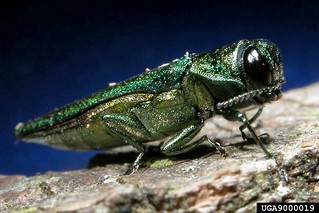Emerald Ash Borer confirmed in six counties; quarantine proposed for 25 counties
Emerald Ash Borer -- Known as EAB, this tiny insect has been enormously destructive
in states where it has been found.
CREDIT MANDATORY -- Image by David Cappeart, Michigan State University. Image via
Bugwood.org.
August 26, 2014
Fast facts
- Emerald ash borer also confirmed in Columbia, Dallas, Ouachita counties
- Proposed quarantine would include 25 counties
- Decision on emergency quarantine to be made Sept. 11
(500 words)
LITTLE ROCK – Twenty-five counties in southern and southwest Arkansas could be subject to quarantine on the movement of firewood, ash nursery stock and ash logs in an effort to halt the spread of the emerald ash borer, state officials said Tuesday.
The emerald ash borer, accidentally imported from Asia and confirmed in the U.S. in 2002, has been blamed for the deaths of tens of millions of trees in the United States and Canada. It has been confirmed in six Arkansas counties. These are: Clark, Columbia, Dallas, Hot Spring, Nevada and Ouachita.
The proposed quarantine would include all hardwood firewood, all ash nursery stock and ash for both saw logs and pulpwood, mulch and compost. The area includes the six infested counties and 19 others as buffer zones: Ashley, Bradley, Calhoun, Cleveland, Drew, Garland, Grant, Hempstead, Howard, Jefferson, Lafayette, Lincoln, Little River, Miller, Montgomery, Pike, Saline, Sevier and Union counties.
A decision on the proposed quarantine would be made Sept. 11 by the Arkansas State Plant Board. One option is to enact an emergency rule that would establish a quarantine that would last 120 days. This time period would allow the ASPB to initiate a process that includes public hearings on the issue.
A task force with members from the Arkansas State Plant Board, USDA-APHIS-PPQ, Arkansas Forestry Commission, University of Arkansas Cooperative Extension Service, Arkansas Forestry Association, Arkansas State Parks, U.S. Army Corps of Engineers, Arkansas Association of Conservation Districts, and Natural Resources Conservation Service met Monday to discuss a possible quarantine.
The quarantine would bar movement of firewood and nursery stock out of the quarantined area to slow the insect’s spread. Firewood should be sourced locally and burned locally, state officials said. (See: www.uaex.uada.edu/media-resources/news/2014/april2014/04-18-2014-Ark-Invasives-Firewood.aspx)
The insect, a mere half-inch long, has expanded its range by hundreds of miles since being discovered in southeastern Michigan. It has since been found in 27 states, including Arkansas.
There was some good news to come from Monday’s meeting,said Tamara Walkingstick, associate director of the Arkansas Forest Resources Center.
“Survey results were negative for all other counties including Pulaski, Mississippi and Independence where suspects or suspect ash tree damage was found” she said.
Signs of infestation
Jon Barry, extension forester for the University of Arkansas System Division of Agriculture said Arkansans should be on the lookout for symptoms of infestation. These include:
- Multiple jagged holes excavated by woodpeckers feeding on ash borer larvae,
- Distinctive D-shaped exit holes left by emerging adult beetles,
- Canopy dieback from top of tree,
- Sprouts arising from the base of the tree,
- Larval tunnels or galleries immediately under the bark of dying ash trees.
Barry said if any of these signs of infestation appear, contact your county extension agent or email the Arkansas State Plant Board at EAB@aspb.ar.gov.
For more information about the emerald ash borer, visit www.emeraldashborer.info or www.arinvasives.org. A fact sheet about the borer may be found at: “Emerald Ash Borer: A potential pest of ash trees in Arkansas”, downloadable at www.uaex.uada.edu/publications/pdf/FSA-7066.pdf.
Pursuant to 7 CFR § 15.3, the University of Arkansas System Division of Agriculture offers all its Extension and Research programs and services (including employment) without regard to race, color, sex, national origin, religion, age, disability, marital or veteran status, genetic information, sexual preference, pregnancy or any other legally protected status, and is an equal opportunity institution.
By Mary Hightower
Cooperative Extension Service
U of Arkansas System Division of Agriculture
Media Contact: Mary Hightower
Dir. of Communication Services
U of A Division of Agriculture
Cooperative Extension Service
(501) 671-2126
mhightower@uada.edu
Related Links
